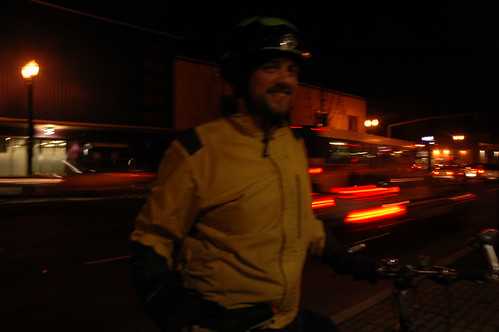 The northbound MLK experience: A lost classic in experimental thrash riding
The northbound MLK experience: A lost classic in experimental thrash riding
I’ve been reading Our Band Could Be Your Life, a history of the U.S. indie music that I didn’t listen to in the 80s. The author clearly honed his catchy style writing record reviews and I was inspired to attempt a similar treatment for some of my regular bike routes around Portland. It’s addictively fun. Here’s the first batch. [The second batch is now posted here.]
Southeast Clinton
Portland’s first bike route to go double platinum. A sturdy crowd pleaser, carrying heavy traffic with timeless ease, assisted by minimalist traffic calming flourishes. The diverter at 39th modestly sets the tone; you only realize upon arrival that it’s what holds the entire thing together. The recent addition of colorful bike corrals and tasteful street sign caps enhance the experience without overwhelming or distracting. A few rough edges along 21st gently remind you that you are still in the U.S.A., but overall this is a bike route at the top of its game. It’s been ready for national play for a decade but is consistently passed over for younger, more expensive routes with mode-separated features.
The Springwater Corridor
Riding the Springwater is a major label experience. You can bring this route home to your parents and raise nary an eyebrow. Parts of it even live up to its hype. Among its seriously good moments are the stretch past the marsh where most days there’s a real heron in the foreground with the mausoleum’s giant, gaudy heron mural in the background. The nature alone almost makes up for the stiltedly narrow path and the near-trainwreck moments between the aggressively lycra’d racers and the slow, wobbling weekend warriors that always make you vow never to return. But even those frustrations seem like a blissful, distant dream, after the trail spits you out into the rumbling industrial grunge of the infamous “gap” between the opera house and the freeway, with its uninterpretable signage and banal gravelly landscape. This section is clearly intended to make this otherwise conservative route appeal to a hip, urban audience, but it’s a tone deaf plea.
MLK
Before it was ruinously remastered to include streetcar tracks, MLK was an underground classic, a thrilling whirlwind of a ride. Though it never gained popular appeal, for those in the know it could take you anywhere fast; you never could keep up, but you never wanted to stop trying. A steady backbeat of rumbling engines overlaid with unsignaled turns and sudden potholes that sprang up overnight could all dissolve into chaos at any moment, but the light timing — just a little too fast for your average rider — broke things up and gave you a chance to process the last stretch and catch your breath for the next one. That’s southbound, of course. Downhill. Northbound, this route proved itself inaccessible even to many die hard fans, with its long, slow climb and frequent atonal highlights provided by honking horns and vocals that were intended to be impassioned but come off as strident. This assault on the senses was at once as unbearable as it was necessary to fully grasp the vernacular of the urban riding experience. But can we blame the masses for choosing to meander up milquetoast Russell instead?